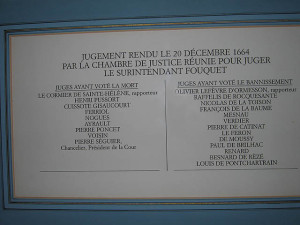Dearest Readers,
I’ve been discussing one of the most beautiful and infamous mansions in the 17th century. Vaux-le-Vicomte was the very chateau that inspired King Louis XIV to build the magnificent Palace of Versailles.
Its original owner was one of the most powerful men of his day–Nicolas Fouquet, Superintendent of Finance. For those who missed the history behind Vaux and Fouquet, you can read Part I and Part II.
At the end of Part II, I mentioned Nicolas Fouquet was arrested on charges of embezzlement of Crown funds on Louis XIV’s 23rd birthday. Fouquet had usurped power and had more influence than the young King. He’d become quite popular in the realm–while most had written Louis off, believing he’d never become any kind of real monarch. (Oh, how wrong they were!)
Louis wasn’t going to just sit back and watch his throne slip away from him. There was no evidence that an actual rebellion was afoot. But since no one took the King seriously, and Fouquet held the country’s purse strings, Louis must have wondered how much longer before Fouquet would run the entire country–not just the finances.
It isn’t easy toppling the mighty.
Louis had to be patient and shrewd. He had Colbert, a civil servant who despised the Superintendent of Finance, review Fouquet’s accounting ledgers and report the malpractices he found. Moreover, for his plan against Fouquet to work, the King had to convince him to quit his parliamentary position. Why? Because if Fouquet was arrested while still a member of parliament, he’d be judged by his peers—other members of parliament. And Fouquet had way too many friends there. Louis wanted him judged by a panel of judges that he’d selected.
Certainly, if the King picked the judges, there was sure to be a favorable outcome for Louis in the end. Right?
Well, kind of.
No one expected what happened. Not even the judges themselves!
 |
| Louis XIV seated with Colbert by his side–to his left in black. |
A Trial That Wouldn’t End.
Fouquet did indeed give up his position in parliament, as the King requested–though this didn’t remove him from his powerful post as Superintendent of Finance. He never expected the King, who’d spent most of his time focused on his ballets, and his mistress, to ever be a threat to him. To ever plot against him and order his arrest.
He was quite surprised when he found himself detained and later in a courtroom, defending his innocence. What surprised and irked the King was how eloquent and convincing Fouquet was in a courtroom. He was, after all, a former lawyer. Fouquet had the courtroom captivated and at times, even charmed.
Fouquet was a patron of the arts. Writers, dramatists and poets wrote poems and sang songs outside the courthouse each day, praising Fouquet and protesting against the charges against him.
The painting above depicting Fouquet’s trial. The trial was a long drawn-out process that lasted three years!
The Verdict At Last!
In December 1664, Fouquet’s fate was finally decided. Above is a list of the judges and how they voted at his trial (click on image for a larger view). The judges on the left-hand side voted for death. The judges on the right voted for perpetual banishment. As you can see, the sentence of banishment won out. But Louis intervened and changed it to perpetual imprisonment. Having expected the sentence of death, he never imagined they’d let Fouquet just walk. The King stated that a man who knew so many state secrets couldn’t simply be set free.
Fouquet was sent to a prison in northern Italy. His young wife was devastated. He spent the remaining twelve years of his life there, mostly in solitary confinement. The King confiscated the furniture, art and orange trees at Vaux and ignored Fouquet’s many letters asking for forgiveness. It wasn’t until the final years of his life that the King permitted Fouquet visitors–his wife and son.
Nicolas Fouquet died in prison at age 65. For a man who had climbed so high, who had women and wealth, influence and prominence…he lost all his glory and disappeared in history.
But not his spectacular chateau.
Vaux-le-Vicomte sits south-east of Paris, still as beautiful as ever.
A DiPasqua Mishap at Vaux!
The table below is one of only two pieces of furniture original to Fouquet’s time. See the marble barrier around the table?
Well, my youngest daughter, who was only six at the time, and I were marveling at the beauty of the table during our visit to Vaux. The room was crowded with tourists moving about. My daughter took a step, forgetting that the small barrier was there and lost her balance. Yup, you guessed it . . she started to fall—toward the table! Her arms shot out, a purely reflexive reaction, and her little hands were about to collide with the priceless statue on top.
I swear my heart stopped in those few seconds.
I caught her around the waist just in the nick of time and kept her from not just falling, but knocking that statue right off! Can you imagine? I could just read the headlines now….Lila DiPasqua’s daughter breaks irreplaceable 350 year old artifact.
Luckily, my daughter didn’t fall and injure herself, the statue is still in one piece—and we’re still allowed back in Vaux. *smiles*
Last but not least….We have a winner!
The winner of my January/February Contest is:
Email me HERE with a mailing address.
















I have truly enjoyed reading about Nicolas Fouquet and Vaux-le-Vicomte .
What a sad ending for him. Thank you so much for sharing all this with us.
And thank goodness you were able to stop your daughter from falling. 🙂
Congrats to the winner as well.
Carol L
Hi Carol!
I’m so delighted you’ve enjoyed this series of posts! Fouquet and Vaux are totally fascinating. Thanks so much for stopping by!! Always a pleasure to chat with you. 🙂
Hugs,
Lila
thank goodness we have you, madame, to rewrite thees story! merci!
Thank you, Thea, for your lovely and endearing comment!
Hugs,
Lila